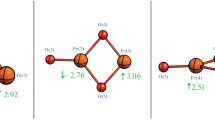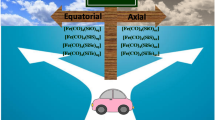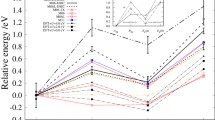Abstract
The extended Hückel method has been used to calculate the electronic structure of “linear” and “perpendicular” complexes of the Fe atom with the N2 molecule. The linear complex is found to be more stable, in agreement with the small amount of available experimental data. Its stabilization is due to the combined action of two effects-promotion of electrons in the σ-core of the complex in the direction of the Fe atom, and promotion in the π-cloud in the opposite direction. In the perpendicular complex, the last effect is almost absent because of t the antibonding nature of the π-bonds, and this explains its lower stability.
Similar content being viewed by others
References
Ya. K. Syrkin, ZhSkh,1, 189, 1960.
L. E. Orgel, An Introduction to Transition Metal Chemistry, Ligand Field Theory, Methuen, London, §9, 3, 1960; L. Orgel, An Introduction to Transition Metal Chemistry, Ligand Field Theory [Russian translation], Mir, Moscow, §9, 3, 1964.
F. Bottomley and S. C. Nyburg, Chem. Commun., 897, 1966.
A. D. Allen, F. Bottomley, R. O. Harris, V. P. Reinsaln, and C. V. Senoff, J. Amer. Chem. Soc.,89, 5595, 1967.
J. P. Collman and J. W. Kang, J. Amer. Chem. Soc.,88, 3459, 1966.
J. P. Collman, M. Kubota, J. Y. Sun, and F. Vastine, J. Amer. Chem. Soc.,89, 169, 1967.
A. Yamamoto, S. Kitazume, L. S. Pu, and S. Ikeda, Chem. Commun., 79, 1967.
M. Wolfsberg and L. Helmholz, J. Chem. Phys.,20, 837, 1952.
R. Hoffmann and W. N. Lipscomb, J. Chem. Phys.,36, 2179, 1962.
G. I. Kagan, G. M. Kagan, and I. N. Fundyler, TEKh [Theoretical and Experimental Chemistry],3, 444, 1967.
Yu. A. Kruglyak, G. G. Dyadyusha, V. A. Kuprievich, L. M. Podol'skaya, and G. I. Kagan, Methods for Calculating the Electronic Structure and Spectra of Molecules [in Russian], Naukova Dumka, Kiev, 1969.
E. Clementi, C. C. J. Roothaan, and M. Yoshimine, Phys. Rev.,127, 1618, 1962.
E. Clementi, “Analytical self-consistent field functions, III, isoelectronic series with 19 to 30 electrons,” IBM Research paper RJ-283, 20 January 1964.
L. C. Cusachs, J. Chem. Phys.,43, S157, 1965.
R. S. Mulliken, in: The Threshold of Space, ed. by B. Armstrong and A. Dalgarno, Pergamon Press, NY, p. 169, 1957.
J. Slater, The Electronic Structure of Molecules [Russian translation], Mir, Moscow, p. 140, 1965.
B. J. Ransil, Rev. Mod. Phys.,32, 239, 1960.
R. S. Mulliken, J. Chem. Phys.,23, 1833, 1955.
Author information
Authors and Affiliations
Additional information
The authors thank G. I. Kagan for providing the EH program.
Rights and permissions
About this article
Cite this article
Kruglyak, Y.A., Yatsimirskii, K.B. Electronic and geometric structure of the complex FeN2 . Theor Exp Chem 5, 197–201 (1969). https://doi.org/10.1007/BF01109662
Issue Date:
DOI: https://doi.org/10.1007/BF01109662




